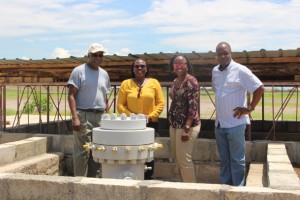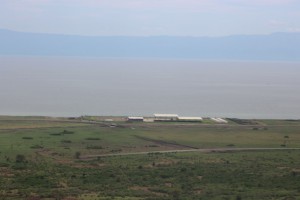Recently the Energy Sector team of the OAGU, in collaboration with the INTOSAI Working Group on Audit of Extractive Industries (WGEI), organized a visit to some of the areas of the Albertine Graben Region where Petroleum activities are taking place as well as to the Karuma site, in Northern Uganda, where a major Hydro-electric project is under construction. The objective of this mission was to familiarize top management at the Office of the Auditor General (OAG) with these significant projects in the Extractive Industries (EI) and energy sectors in Uganda. The two project sites represent initiatives that will impact heavily on Uganda for decades to come. The Kingfisher installation in the Albertine Graben petroleum field was visited Monday 11th April while the Karuma hydroelectric project site was visited Tuesday 12th April.

Some 6.5 billion barrels of oil have so far been discovered in Uganda and several licences, both exploration and production, have been granted. The main private actors involved in petroleum activities in Uganda are Total E&P, Tullow Uganda oil Pty and CNOOC (China National Offshore Oil Corporation). The Kingfisher block is operated by CNOOC which formally received the production license in 2013. During the mission the team observed several drilling pads as well as an airfield which would facilitate logistical needs when production starts as well as several stretches of road that have been constructed or upgraded to facilitate access to the area.
In addition the team visited the site which has been acquired for the proposed refinery measuring 29km2 .

The works to construct the Karuma hydroelectric power plant started in 2013 with Sinohydro Group Ltd as the main contractor. This project, which is estimated to cost about 1.7 billion USD, is located at the Karuma Falls on the River Nile. It is estimated that the project is today at about 30% completion rate and when work is scheduled to end in 2018 the total capacity of the plant will be 600 MW. The OAGU team visited, among other installations, the power house excavations which is about 80 meters below the ground and represents a major part of the large underground installations of the dam project.
WGEI Community of Practice discussed the implications of such large EI and energy projects on the SAI with the Energy Sector audit team of the OAGU and the head of the WGEI Secretariat.
WGEI CoP: What role does a SAI play in general when such huge energy projects are undertaken by the government, and how do we ensure that revenues from the EI sector finally benefits the population?
OAGU Energy Sector: The role of the SAI will depend on its particular mandate. For the case of SAI Uganda, the mandate is to audit and report on the public accounts of Uganda. This is to ensure that public resources are spent efficiently so that the population of the country gets value for public money. OAGU will thus look at all the stages of implementation of these energy projects and consider if public money has been used according to relevant standards, rules and regulations. We will for example look at the procurement process conducted, the financing of the projects, and the overall progress of the projects. We can also go in and look at whether the relevant government monitoring entities are handling data from seismic surveys according to rules and regulations, if the licensing rounds and contract awarding is done in compliance with relevant rules and regulations, if the government revenues from the sector is used in compliance with relevant legislation etc. In Uganda, unlike many other countries we are also directly reviewing the petroleum recoverable cost to see if they are correctly reported.
Head of the WGEI secretariat: I would like to add that the role of a SAI is to give an objective assessment of the performance of such huge projects whose completion span over several years and has long term implication on citizens. The objective assessment can only be based on the SAI’s capacity to appreciate and have adequate understanding of the project right from the beginning through the various stages. This understanding requires being able to keep track of the project process outputs and if possible, design audits based on the key project process outputs. Understanding the project right from inception and visiting such project during implementation at sites provides SAI top management this important opportunity to understand the project better and be able to adequately guide audit planning in order to provide objective assessment.
For projects with long completion timeline, it is appropriate for SAIs to break the project into key auditable stages so that SAI’s can provide recommendation at the appropriate process outputs in order that the utilization of the recommendations can be implemented to improve the next project process rather than wait to provide recommendations only relevant for future such projects when the existing one is beyond correction.
WGEI CoP: What are the main characteristics of the EI sector in relation to public auditing?
OAGU Energy Sector: It is important to understand that the energy sector is a complex sector and this needs to be matched by adequate skills and resources of any particular SAI. Another characteristic of the sector is the high value of the financial flows on the investment side as well as inflows in form of revenues (for both government and the private sector). The projects are most often long term and can last over several decades, something that also requires SAIs to think long term in relation to auditing strategies. Due to the fact that the projects in the EI and energy sector often gets a lot of media attention there is also an interest in the general population to understand if the government is doing what it is supposed to do. The SAI therefore has to provide assurance to the public on the government’s role.
WGEI CoP: What are some of the approaches that public auditors can use when faced with challenges of auditing the EI sector?
OAGU Energy Sector: Long term planning is essential for a SAI to undertake audits in EI. It is important that a strategic plan (say 5 year) is formulated to guide the office. This plan should be aligned to the office strategy and also in line with the major trends of the nation’s extractive industry
Auditing of the EI sector requires specialized skills as well as adequate resources in form of HR, finances etc. At the OAG, initially in the absence of such skill, we outsourced to private audit firms, where a team of OAG staff is attached to understudy. We are presently moving away from this strategy as the capacity is being improved. OAG has also improved its internal capacity through collaborations with experienced SAIs. Such collaborations consist of experts joining audit projects to undertake on job training, benchmarking trips and joint audits. We have also initiated drafting of guidelines on topics such as transfer pricing which are good for ensuring uniform approaches and documentation of organizational knowledge on complex areas.
We are also beginning to draw benefits from the information sharing that is happening within the Community of Practice of the WGEI.
WGEI CoP: What are the main challenges related to the impact of public audits in the EI sector in Uganda?
OAGU Energy Sector: As you may be aware, the Parliament of Uganda is the primary recipient of our audit reports, so in relation to the impact a lot depends on how the reports are dealt with at that level. In that context there may be a challenge that some of the reports are only discussed after a significant delay depending on Parliamentary timetable. At the same time it is true that some of our repots may be of quite a technical nature, making them less assimilated by non-technical persons and subject to various interpretation. There is also an issue that some reports contain confidential information and will therefore only be accessed by restricted/authorized individuals.
In addition, long term contracts used in the sector between Companies and Government may be hard to change even if it is discovered that they are not optimal for the country.
WGEI CoP: What do you think other Supreme Audit Institutions could learn from SAI Uganda?
OAGU Energy Sector: One of the advantages we have at the OAGU is the dedicated Energy Sector team. This team consistis of experts from both financial and value for money directorates with particular knowledge and experience in auditing the energy sector. The energy sector covers everything related to the EI sector in addition to electricity.
We are also developing a new 5 year strategic plan for the sector to take us to 2021, the first one coming to an end in 2016. As EI projects are long term projects it is important that also the SAI has a long horizon.
The sector has also initiated capacity building initiatives to ensure that the staff have sufficient knowledge about the EI sector. Several of our staff have, for example, been supported to graduate with specialized master degrees in EI audits abroad. We have also developed partnerships with other SAIs such as SAI Norway and SAI Sweden.
In addition to these site visits, The SAI is also undertaking training of Top Management in short courses to understand and appreciate the sector.
It is also important to have a cordial working relationship with the implementing government agencies to enhance information and document flow during audits and also implementation of audit recommendations.
WGEI CoP: What kind of initiatives would you like to see taken by WGEI to help the OAGU and other SAIs meet challenges that rapid changes in the energy sector constitutes?
OAGU Energy Sector: The WGEI network could be used to suggest and organize benchmarking activities between SAIs that have a need – expertise match. We would also like to see more documentation on uniform approaches such as shared guidelines and manuals related to the audit of the Extractive Industries sector developed and shared among the members. Collaborative or joint audit in the EI sector is another element that we would like to see developed further, as this is a practical approach for SAIs to learn from each other. The WGEI CoP should also continue to share resources on the WGEI webpage as it does today and continue to upload relevant documentation, and it could be a good idea to think of using blogs.
Head of the WGEI secretariat: WGEI should be able to gather challenges from various SAIs and consolidate them to group them into various specific crosscutting challenges thus bringing together SAIs with similar challenges and engage them in efforts to address the challenge. If challenges could be addressed through designing joint training programs or identifying existing training which can address the problem WGEI can interest itself to do this. If the matter requires developing guidelines then WGEI can help bring the SAIs together to develop one. If joint or collaborative audit approach can address the challenge then WGEI could assist in coordinating the SAIs in initiating such joint or collaborative audits.





